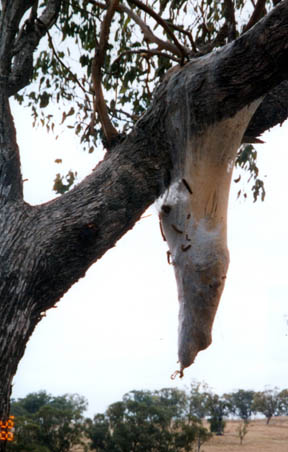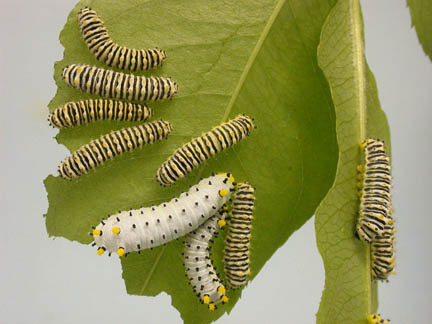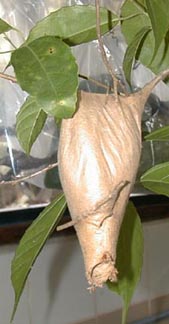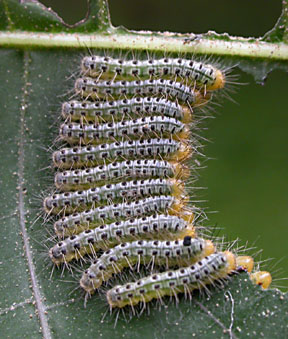


| . |
Other species of social caterpillars
 |
 |
 |
Pachymeta
robusta Aurivillius (Lasiocampidae), the Msasa Worm.
Photographed on their host plant, the Msasa Tree (Brachystegia spiciformis). Larva feed at night and cluster by
day. Thanks to Ric Piegler for help in identifying these
caterpillars and to Shepherd Mutyora for the photographs.
 |
 |
 |
Above and right: "Bag-shelters" of Australian processionary caterpillars. Although a single species Ochrogaster lunifer has been indentified, differences in nesting habits and behavior indicate that there are at least two species. Photographs courtesy of Peter Hill. |
 |
 |
 |
An unidentified species of
processionary observed at Tapanti National Park, Costa Rica, in
late April. Photographs courtesy of Kenji Nishida and Mr. Hotta.
 |
 |
 |
 |
| The nest of a caterpillar identified as Eutolype
sp. (Lasiocampidae)
observed at La Selva Biological Station in Costa Rica. Nothing is
known of its behavior. ( From: http://www.tulane.edu/~ldyer/lsacat/index_frames.htm) |
 |
A social species, possible the early instar of Ammalo helops (Arctiidae) . These were photographed on Ficus near Chamela, Mexico. |
The larvae and nest of the cherry web-spinning sawfly Neurotoma fasciata on Prunus serotina. Photographed in Cortland, NY |
 |
 |
 |
Left, an unidentified caterpillar photographed near Tepic, Mexico. |
| Two North American species of social caterpillars whose larvae lay down and follow trails that serve to keep the caterpillars together as they move about the host. (Left) larvae of the brown trail moth, Euproctis chrysorrhoea (Lymantriidae). (Right) Hemileuca maia (Saturniidae), the larvae of which are processionaries. |  |
 |
 |
 |
 |
Above: (Left) Second instar
larvae of the processionary Euselasia
chrysippe (Riodinidae),
(Center) Fourth instars, and (Right and
Below)
Sixth instars. The larvae feed on Miconia
calvescens in
Costa Rica. Photos courtesy of Kenji Nishida
and the Miconia project by the Institute of Pacific Islands
Forestry, USDA Forest Service-University of Costa Rica
 |
| Caterpillars of Pereute
charops (Pieridae). The late instar larvae are
central place foragers. The caterpillars feed on mistletoe. Photo from Kenji Nishida (Costa Rica) |
 |
|
| An unusual mode of mass locomotion
exhibited by the hymenopteran Perreyia
sp. The caterpillars feed on leaf litter on the
ground.
Photographed by J. Mackin along the Shiripuno River near Coca, Ecuador, August, 2007. |
En masse movement of fungus gnat larvae. Photographed near Fairbanks, Alaska, July 2007. Image by Daniel L. Osborne. |
Below a procession of Euselasia chrysippe (Riodinidae) in Costa Rica. Image from Kenji Nishida
.